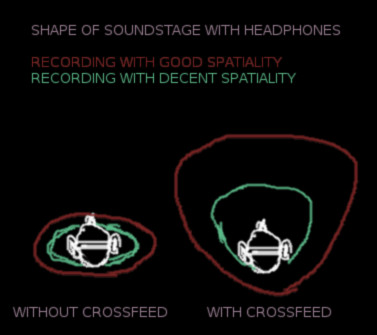I've had the opportunity for the past 4 months to experiment with the addition of cross-feed to my headphone rig (see my signature). In my case it's a custom designed 6 level balanced cross-feeder. I'm extremely pleased with this major enhancement to my listening experience and I find several theoretical issues keep swirling around in my thoughts as I learn more and more about just what cross-feed does to the sounds I'm hearing through my headphone. I'll address just one of these issues below.
First, just so you know at least one of my biases up front, I'm a dedicated 2-channel audiophile. I've never particularly enjoyed any surround-sound type home theater set up I've ever auditioned finding the multiple sound sources confusing and unnatural.
I'm also aware of the rather strong negative view toward cross-feed in general among Head-Fi members and by the headphone gear industry as well, as is made obvious by the rarity of cross-feed implementation with either headphone amps or stand alone cross-feed devices such as mine. (I had to have one custom made only because nothing like it exists in the marketplace that I've been able to find.)
So the issue,
First, there's no question that cross-feed does indeed narrow the width of the soundstage and this seems to be the primary objection to it's implementation by most listeners. The more cross-feed, the narrower the soundstage until you reach maximum-- a mono signal. Cross-feed, in my experience, has no noticeable effect on the depth of the soundstage.
The question that arises: Is having the widest possible soundstage with your headphone gear always desirable as seems to be the opinion of virtually everyone contributing to Head-Fi?
I've come to the conclusion that the answer is definitely not.
The first inkling I had that extreme soundstage width might not be desirable, indeed quite unnatural sounding, was when I got a chance to audition an HD-800 rig using the Decware Taboo MK II. The accuracy and clarity were amazing to be sure but the extreme width of the soundstage was quite disorienting and unnatural to me.
Using cross-feed these last several months has demonstrated to me quite clearly that this kind of presentation, where the sound sources are coming at your brain from so far around the sides of your head is not only contrary to what one hears at a live performance but confusing and disorienting to the brain in a way that is actually fatiguing over time. I've noticed that adding cross-feed not only sounds much more like an actual live performance but is a much more relaxed presentation without the fatigue with extended listening.
No doubt all this is irrelevant to many of the genres of electronic music which deliberately use channel separation effects as a major element. My listening however is primarily acoustic classical music and, of course, when I do listen to electronic music, I turn off the cross-feeder.
I suspect that the generally negative views I've seen by most Head-Fiers to the idea of cross-feed stems from the saturation of our culture with the implementation of surround-sound in movie theaters and home theater set-ups. For many, that dizzying effect of the sounds coming at you from all directions at once sounds normal. It never has, though, to me.
I'm also well aware that cross-feed tends to diminish the micro-detail of the perceived sound signal in the same way that listening to loudspeakers does (i.e. the natural cross-feed heard by our ears in the absence of headphones). Again, this is natural and realistic to me. By analogy, one doesn't tend to appreciate a Picasso painting using a magnifying glass.





